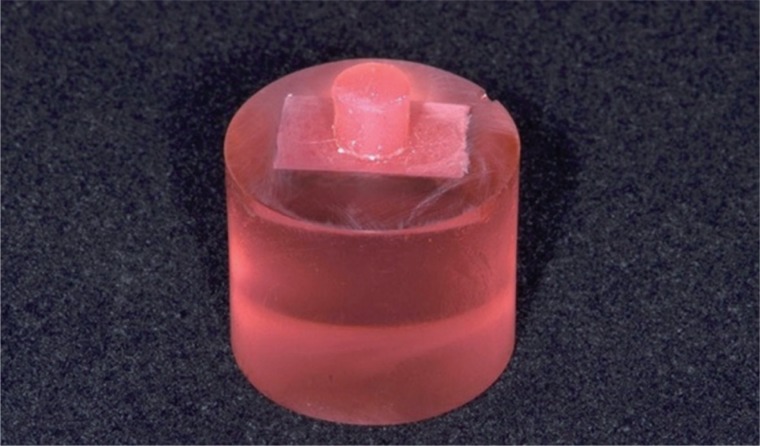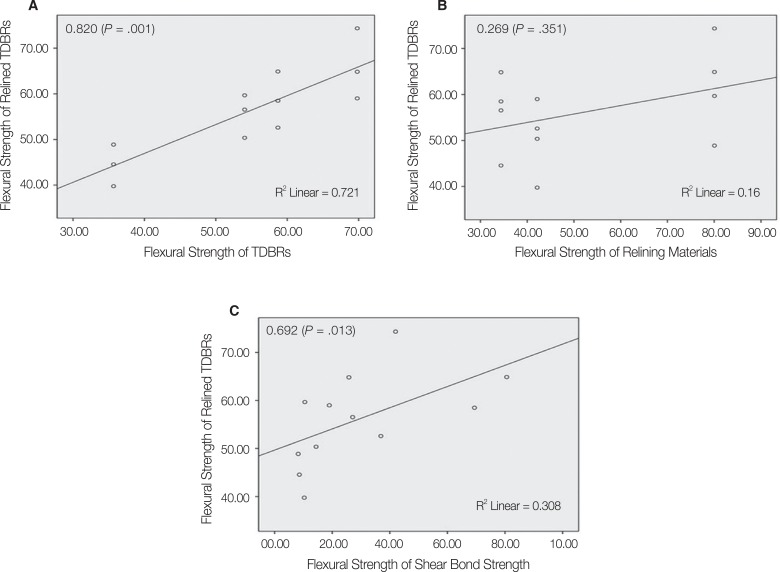J Adv Prosthodont.
2018 Oct;10(5):361-366. 10.4047/jap.2018.10.5.361.
Effects of relining materials on the flexural strength of relined thermoplastic denture base resins
- Affiliations
-
- 1Department of Medicine, Graduate School, Korea University, Seoul, Republic of Korea.
- 2Department of Biomedical Sciences, Graduate School, Korea University, Seoul, Republic of Korea.
- 3Department of Prosthodontics, Korea University Guro Hospital, Seoul, Republic of Korea. wddc@korea.ac.kr
- KMID: 2422872
- DOI: http://doi.org/10.4047/jap.2018.10.5.361
Abstract
- PURPOSE
The aim of this study was to evaluate the effects of relining materials on the flexural strength of relined thermoplastic denture base resins (TDBRs).
MATERIALS AND METHODS
For shear bond strength testing, 120 specimens were fabricated using four TDBRs (EstheShot-Bright, Acrytone, Valplast, Weldenz) that were bonded with three autopolymerizing denture relining resins (ADRRs: Vertex Self-Curing, Tokuyama Rebase, Ufi Gel Hard) with a bond area of 6.0 mm in diameter and were assigned to each group (n=10). For flexural strength testing, 120 specimens measuring 64.0×10.0×3.3 mm (ISO-1567:1999) were fabricated using four TDBRs and three ADRRs and were assigned to each group (n=10). The thickness of the specimens measured 2.0 mm of TDBR and 1.3 mm of ADRR. Forty specimens using four TDBRs and 30 specimens using ADRRs served as the control. All specimens were tested on a universal testing machine. For statistical analysis, Analysis of variance (ANOVA) with Tukey's test as post hoc and Spearman's correlation coefficient analysis (P=.05) were performed.
RESULTS
Acry-Tone showed the highest shear bond strength, while Weldenz demonstrated the lowest bond strength between TDBR and ADRRs compared to other groups. EstheShot-Bright exhibited the highest flexural strength, while Weldenz showed the lowest flexural strength. Relined EstheShot-Bright demonstrated the highest flexural strength and relined Weldenz exhibited the lowest flexural strength (P < .05). Flexural strength of TDBRs (P=.001) and shear bond strength (P=.013) exhibited a positive correlation with the flexural strength of relined TDBRs.
CONCLUSION
The flexural strength of relined TDBRs was affected by the flexural strength of the original denture base resins and bond strength between denture base resins and relining materials.
Figure
Reference
-
1. Takabayashi Y. Characteristics of denture thermoplastic resins for non-metal clasp dentures. Dent Mater J. 2010; 29:353–361. PMID: 20644329.
Article2. Goiato MC, Santos DM, Haddad MF, Pesqueira AA. Effect of accelerated aging on the microhardness and color stability of flexible resins for dentures. Braz Oral Res. 2010; 24:114–119. PMID: 20339724.
Article3. Yunus N, Rashid AA, Azmi LL, Abu-Hassan MI. Some flexural properties of a nylon denture base polymer. J Oral Rehabil. 2005; 32:65–71. PMID: 15634304.
Article4. Katsumata Y, Hojo S, Hamano N, Watanabe T, Yamaguchi H, Okada S, Teranaka T, Ino S. Bonding strength of autopolymerizing resin to nylon denture base polymer. Dent Mater J. 2009; 28:409–418. PMID: 19721277.
Article5. Kasumata Y, Hojo S, Ino S, Hamano N, Watanabe T, Suzuki Y, Ikeya H, Morino T, Toyoda M. Mechanical characterization of a flexible nylon denture base material. Bull Kanagawa Dent Coll. 2007; 35:177–182.6. Takahashi Y, Hamanaka I, Shimizu H. Effect of thermal shock on mechanical properties of injection-molded thermoplastic denture base resins. Acta Odontol Scand. 2012; 70:297–302. PMID: 21793643.
Article7. Fueki K, Ohkubo C, Yatabe M, Arakawa I, Arita M, Ino S, Kanamori T, Kawai Y, Kawara M, Komiyama O, Suzuki T, Nagata K, Hosoki M, Masumi S, Yamauchi M, Aita H, Ono T, Kondo H, Tamaki K, Matsuka Y, Tsukasaki H, Fujisawa M, Baba K, Koyano K, Yatani H. Clinical application of removable partial dentures using thermoplastic resin-part I: definition and indication of non-metal clasp dentures. J Prosthodont Res. 2014; 58:3–10. PMID: 24461323.
Article8. Fueki K, Ohkubo C, Yatabe M, Arakawa I, Arita M, Ino S, Kanamori T, Kawai Y, Kawara M, Komiyama O, Suzuki T, Nagata K, Hosoki M, Masumi S, Yamauchi M, Aita H, Ono T, Kondo H, Tamaki K, Matsuka Y, Tsukasaki H, Fujisawa M, Baba K, Koyano K, Yatani H. Clinical application of removable partial dentures using thermoplastic resin. Part II: Material properties and clinical features of non-metal clasp dentures. J Prosthodont Res. 2014; 58:71–84. PMID: 24746524.
Article9. Takahashi H, Kawada E, Tamaki Y, Teraoka F, Hosoi T, Yoshida T. Basic properties of thermoplastic resins for denture base material referred to non-clasp denture. J Jpn Dent Mater. 2009; 28:161–167.10. Hamanaka I, Takahashi Y, Shimizu H. Mechanical properties of injection-molded thermoplastic denture base resins. Acta Odontol Scand. 2011; 69:75–79. PMID: 20873995.
Article11. Arena CA, Evans DB, Hilton TJ. A comparison of bond strengths among chairside hard reline materials. J Prosthet Dent. 1993; 70:126–131. PMID: 8371174.
Article12. Takahashi Y, Chai J. Shear bond strength of denture reline polymers to denture base polymers. Int J Prosthodont. 2001; 14:271–275. PMID: 11484577.13. Chai J, Takahashi Y, Kawaguchi M. The flexural strengths of denture base acrylic resins after relining with a visible-light-activated material. Int J Prosthodont. 1998; 11:121–124. PMID: 9709600.14. Arima T, Murata H, Hamada T. Analysis of composition and structure of hard autopolymerizing reline resins. J Oral Rehabil. 1996; 23:346–352. PMID: 8736448.
Article15. Hamanaka I, Shimizu H, Takahashi Y. Shear bond strength of an autopolymerizing repair resin to injection-molded thermoplastic denture base resins. Acta Odontol Scand. 2013; 71:1250–1254. PMID: 23339746.
Article16. Hamanaka I, Shimizu H, Takahashi Y. Bond strength of a chairside autopolymerizing reline resin to injection-molded thermoplastic denture base resins. J Prosthodont Res. 2017; 61:67–72. PMID: 27238884.
Article17. da Cruz Perez LE, Machado AL, Canevarolo SV, Vergani CE, Giampaolo ET, Pavarina AC. Effect of reline material and denture base surface treatment on the impact strength of a denture base acrylic resin. Gerodontology. 2010; 27:62–69. PMID: 19371387.
Article18. Takahashi Y, Kawaguchi M, Chai J. Flexural strength at the proportional limit of a denture base material relined with four different denture reline materials. Int J Prosthodont. 1997; 10:508–512. PMID: 9495170.19. Archadian N, Kawano F, Ohguri T, Ichikawa T, Matsumoto N. Flexural strength of rebased denture polymers. J Oral Rehabil. 2000; 27:690–696. PMID: 10931264.
Article20. Seo RS, Murata H, Hong G, Vergani CE, Hamada T. Influence of thermal and mechanical stresses on the strength of intact and relined denture bases. J Prosthet Dent. 2006; 96:59–67. PMID: 16872932.
Article21. Reis JM, Vergani CE, Pavarina AC, Giampaolo ET, Machado AL. Effect of relining, water storage and cyclic loading on the flexural strength of a denture base acrylic resin. J Dent. 2006; 34:420–426. PMID: 16580115.
- Full Text Links
- Actions
-
Cited
- CITED
-
- Close
- Share
- Similar articles
-
- Comparison of flexural strength according to thickness between CAD/CAM denture base resins and conventional denture base resins
- A comparison study on shear bond strength of 3D printed resin and conventional heat-cured denture base resin to denture relining materials
- Physical properties and color stability of injection-molded thermoplastic denture base resins
- A Study on the Bond Strength of Reline Resin to Pressure Injection Type Thermoplastic Denture Base Resin
- Nonthermal plasma on the shear bond strength of relining resin to thermoplastic denture base resin




